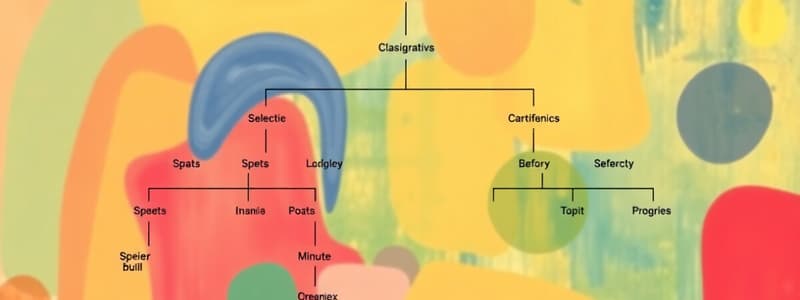Podcast
Questions and Answers
Which characteristic primarily determines whether organisms belong to the same species?
Which characteristic primarily determines whether organisms belong to the same species?
- Having the same nutritional requirements.
- Inhabiting the same geographical location.
- Ability to interbreed and produce fertile offspring. (correct)
- Sharing identical physical appearances.
Which of the following represents the correct order of taxonomic classification, from broadest to most specific?
Which of the following represents the correct order of taxonomic classification, from broadest to most specific?
- Species, genus, family, order, class, phylum, kingdom, domain.
- Kingdom, domain, phylum, class, family, genus, order, species.
- Domain, phylum, kingdom, class, order, family, genus, species.
- Domain, kingdom, phylum, class, order, family, genus, species. (correct)
Why is the use of scientific names important in biology?
Why is the use of scientific names important in biology?
- To create confusion among scientists, thus encouraging further research.
- To ensure that all scientists use the same name for a specific organism, regardless of the language they speak. (correct)
- To allow each country to have its own unique name for every organism.
- To make the classification of organisms more complex and challenging.
Which of the following best describes the key difference between prokaryotic and eukaryotic cells?
Which of the following best describes the key difference between prokaryotic and eukaryotic cells?
Which domain includes organisms known for living in extreme environments, such as high temperatures or high salinity?
Which domain includes organisms known for living in extreme environments, such as high temperatures or high salinity?
What is the primary role of fungi in an ecosystem?
What is the primary role of fungi in an ecosystem?
In binomial nomenclature, what does the first part of a scientific name represent?
In binomial nomenclature, what does the first part of a scientific name represent?
Methanogens, halophiles and thermophiles are all examples of organisms classified under which of the following?
Methanogens, halophiles and thermophiles are all examples of organisms classified under which of the following?
Which kingdom includes organisms that are primarily unicellular or multicellular, and can be animal-like, plant-like, or fungus-like?
Which kingdom includes organisms that are primarily unicellular or multicellular, and can be animal-like, plant-like, or fungus-like?
What characteristic is unique to the Kingdom Plantae?
What characteristic is unique to the Kingdom Plantae?
Which of the following is an example of a species from the Bacteria domain that plays a beneficial role in the human body?
Which of the following is an example of a species from the Bacteria domain that plays a beneficial role in the human body?
Which of the following describes the correct way to write the scientific name of a species?
Which of the following describes the correct way to write the scientific name of a species?
If two organisms belong to the same class, what other taxonomic categories must they also share?
If two organisms belong to the same class, what other taxonomic categories must they also share?
Which of the following is the key characteristic of vertebrates that distinguishes them from invertebrates?
Which of the following is the key characteristic of vertebrates that distinguishes them from invertebrates?
How do thermophiles contribute to their ecosystems?
How do thermophiles contribute to their ecosystems?
Which statement correctly identifies a similarity between Bacteria and Archaea?
Which statement correctly identifies a similarity between Bacteria and Archaea?
What is the role of peptidoglycan in bacteria?
What is the role of peptidoglycan in bacteria?
If a new organism is discovered that thrives in highly acidic conditions, to which domain would it MOST likely belong?
If a new organism is discovered that thrives in highly acidic conditions, to which domain would it MOST likely belong?
How does classifying organisms contribute to our understanding of the natural world?
How does classifying organisms contribute to our understanding of the natural world?
Which of the following characteristics is a defining feature of organisms in the Kingdom Animalia?
Which of the following characteristics is a defining feature of organisms in the Kingdom Animalia?
Flashcards
What are species?
What are species?
A group of similar organisms capable of interbreeding.
What is Binomial nomenclature?
What is Binomial nomenclature?
The universal way to name species using genus and species names.
What is a domain?
What is a domain?
The broadest classification of organisms.
What is a kingdom?
What is a kingdom?
Signup and view all the flashcards
What is a class?
What is a class?
Signup and view all the flashcards
What is an order?
What is an order?
Signup and view all the flashcards
What is a phylum?
What is a phylum?
Signup and view all the flashcards
What is a family?
What is a family?
Signup and view all the flashcards
What is a genus?
What is a genus?
Signup and view all the flashcards
What are the three domains?
What are the three domains?
Signup and view all the flashcards
Define Eukaryotes
Define Eukaryotes
Signup and view all the flashcards
Define Prokaryotes
Define Prokaryotes
Signup and view all the flashcards
What is a Scientific Name?
What is a Scientific Name?
Signup and view all the flashcards
What are Archaebacteria?
What are Archaebacteria?
Signup and view all the flashcards
What are Methanogens?
What are Methanogens?
Signup and view all the flashcards
What are Halophiles?
What are Halophiles?
Signup and view all the flashcards
What are Thermophiles?
What are Thermophiles?
Signup and view all the flashcards
What is Eubacteria?
What is Eubacteria?
Signup and view all the flashcards
What are the shapes of bacteria?
What are the shapes of bacteria?
Signup and view all the flashcards
What are Eukarya?
What are Eukarya?
Signup and view all the flashcards
Study Notes
Classifying Organisms
- Living organisms exhibit diverse characteristics and are classified based on their similarities and differences.
- Understanding the classification of different living organisms is an important part of this study
Species
- Refers to similar individuals capable of interbreeding and producing offspring
- Species form part of the taxonomic rank used to classify organisms
- Millions of species inhabit the Earth and await discovery
Classification System
- Organisms are grouped and classified based on similarities
- Scientists assign universal scientific names to each species
- The taxonomic classification system includes: domain, kingdom, phylum, class, order, family, genus, and species
Taxonomic Hierarchy
- Domain: The broadest category
- Kingdom: Subdivided from domain
- Phylum: Subdivided from kingdom and contains different classes
- Class: Contains several orders
- Order: Contains different families
- Family: Contains several genera
- Genus: Includes the smallest groups of various species sharing characteristics & traits
Three-Domain System
- Includes Archaea, Bacteria, and Eukarya
Eukaryotes vs Prokaryotes
- Eukaryotes:
- They are multi-cellular organisms
- They have two or more cells
- They contain membrane-bound organelles/nuclei with genetic information
- Prokaryotes:
- They are unicellular organisms
- They composed of one cell
- They lack membrane-bound organelles/nucleus but contain nucleoid to store their DNA
Division of Domains
- Prokaryotic organisms are divided into Archaea and Bacteria
- Eukaryotic domain includes protists, fungi, plants, and animals
Scientific Name
- Organisms are identified using a scientific name
- Scientific naming is called binomial system/nomenclature with genus and species names
- Scientific names use Latin language and are italicized (typed) or underlined (handwritten)
Genus and Species Names
- Genus: The first letter is capitalized
- Species: The first letter is written in lower case
Kingdom Classifications
- Early studies suggested two-kingdom classifications
- Current evidence supports six-kingdom classification: Archaebacteria, Eubacteria, Protist, Fungi, Plant, and Animal kingdoms
Archaea Domain: Kingdom Archaebacteria
- Archaebacteria organisms are microscopic
- They are unable to be seen without aid
- They thrive in extreme environments
- Examples are Methanogens, halophiles, and thermophiles
Methanogens
- Can thrive at the bottom of lakes, swamps, and rice fields
- Can survives without oxygen by producing methane gas
- Methane, also known as biogas, is a natural gas usable for alternative energy
Halophiles
- Live in salty environments
- Examples include Halococcus dombrowski and Halobacterium salinarum
Thermophiles
- Live in very high tempuratures
- They inhabit volcanic hot springs (80-110°C), and deep-sea openings, (hot water exceeding 250°C)
- They produce essential nutrients or food, turning themselves into releasable hydrogen sulfide (H2S)
Bacteria Domain
- Eubacteria are unicellular and microscopic
- Its cell wall contains peptidoglycan
- They vary in shape and are found nearly everywhere
- They are found in in soil, water, air, or even on uncooked meat or food, in your body, or even on spoiled food
- Some cause disease/harm, but some are important to the environment
- They are used in food production (yogurt & cheese) and in digestive tracts
Bacteria Classification
- Classified by shapes: cocci, bacilli, and spirilla
- Arrangements: pairs (diplococcus), chains (streptococcus), or clusters (staphylococcus)
- Bacilli also occur in chains (streptobacillus)
Eukarya
- Eukaryotic organisms contain membrane-bound organelles, including a nucleus containing genetic material
- They are divided into Animalia, Plantae, Protista, and Fungi Kingdoms
Animalia
- These organisms are eukaryotic and multicellular
- They do not have cell walls but possesses tissues and organs
- Some Animalia feed their young using their mammary glands
- Animalia includes vertebrates (with backbones) and invertebrates (without backbones
Plantae
- Creates it's own food
- Known as producers because they use sunlight to produce food through photosynthesis
- Has cell walls and chlorophyll to capture light energy
- They converts captured energy into food (sugar, starch, carbohydrates)
- This kingdom includes vascular plants (ferns, cycads) and non-vascular plants (moss, liverworts)
Fungi
- Decomposers of dead organic material that recycles nutrients
- Used in medication to produce antibiotics and penicillin
- Its is an Animal kingdom the effects humans resulting in diseases (athlete's foot)
Protista
- These are unicellular/multicellular organisms including amoeba, seaweed, algae, and malaria
- Some Protista are animal-like, some plant-like, and some fungus-like
- Some are food for animals
- Examples incluide seaweeds which are used as thickeners in ice cream that produce oxygen
Studying That Suits You
Use AI to generate personalized quizzes and flashcards to suit your learning preferences.




